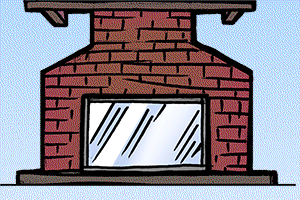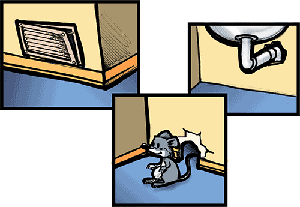
Location: House Entry
Mission: Repair air leaks on doors and windows.
Air leaks around doors and windows are huge sources of energy waste. According to the US Department of Energy, almost half of your family’s power bill goes toward heating and cooling the home. The air conditioner and heater keep the air at a comfortable temperature inside your home. During the summer, leaks let the cool conditioned air out of the house while letting hot air inside. During winter, leaks let the warm air from your heater out of the house while letting cold air inside.
A leak causes the power bill to go up. Leaks make your heater and air conditioner work harder, which can shorten their lives.
Test for Drafts
 T
T
Here’s a list of things you’ll need: a 12-inch ruler or stick, some scotch tape, and a piece of plastic food wrap about half as long as the ruler or stick (tear off enough to look like a big rectangle, 2 short sides and 2 long).
Here’s how to put your Draft-O-Meter together:
1. Use the tape to stick one of the short sides to the ruler or stick. The other side of the plastic should hang free.
2. Test your Draft-O-Meter by blowing on the plastic wrap to see how it moves. Blow hard, then softly.
Now you’re ready to check your home!
Hold your Draft-o-Meter by the end of the ruler or stick so that the plastic wrap hangs straight down. Walk near door facings, windows, or dryer vent openings. Does your plastic wrap move because air is seeping in around these places?
In the winter, air from the outside can seep in around windows and doors and make your home colder, so that your heater has to work harder. The nice warm air in your house can also be escaping through the window panes.
In the summer, hot air from the outside can seep in and make your house hotter, making it hard for you to stay cool.
Knock the “draftees” out of your home. Here are some ways:
• Make sure windows and doors are closed and don’t have any large gaps.
• Cover windows with shades or curtains on drafty, cloudy winter days to keep warm air in your home. On sunny winter days, open curtains to allow sunlight to help warm your home’s air.
• Cover windows in the hottest part of summer days to help your home stay cooler.
• Check unused stoves or fireplaces to make sure flues (openings for smoke to go out) in chimneys are closed.
Air Leaks at Doors
Check the seals on the doors that enter the house. Make sure that the door closes tightly. Have your family install weather stripping on the door frames to seal any leaks. Also, replace worn thresholds.
The biggest leak of all with doors occurs when you leave the door open! When entering and leaving the house, shut the door as quickly as possible to prevent air-conditioned or heated air from escaping the house.
Air Leaks at Windows
 Check the seals on your windows and install weather-stripping where needed. This is especially important around window unit air conditioners.
Check the seals on your windows and install weather-stripping where needed. This is especially important around window unit air conditioners.
In addition to air leaks, energy can also be wasted directly through the window. In the wintertime, cold air up against the outside of the window makes the window cold. The cold window makes the air on the inside of the house colder. In the summer time, heat gets into the house the same way. Putting in special double-paned windows reduces this unwanted heating or cooling.
Air Leaks on Fireplaces
 If your house has a fireplace, all your energy savings could be going up the chimney!
If your house has a fireplace, all your energy savings could be going up the chimney!
Make sure the flue is closed except when using the fireplace. If the flue is open when you don’t have a fire, heated air or cooled air can escape out of your chimney. As an added protection, put a piece of clear plexiglass in front of the fireplace to make sure hot air or cold air can’t escape through the chimney when you don’t have a fire.
Check other places for air leaks
 Locate and repair other places where air can leak from your home. These could include spaces around pipes, vents and cables as well as broken siding and masonry. Fix these problem areas by replacing parts or caulking or covering them. Fixing these areas will keep not only the Power Bandit away, but also make it harder for other pests such as mice and cockroaches to enter your home.
Locate and repair other places where air can leak from your home. These could include spaces around pipes, vents and cables as well as broken siding and masonry. Fix these problem areas by replacing parts or caulking or covering them. Fixing these areas will keep not only the Power Bandit away, but also make it harder for other pests such as mice and cockroaches to enter your home.
